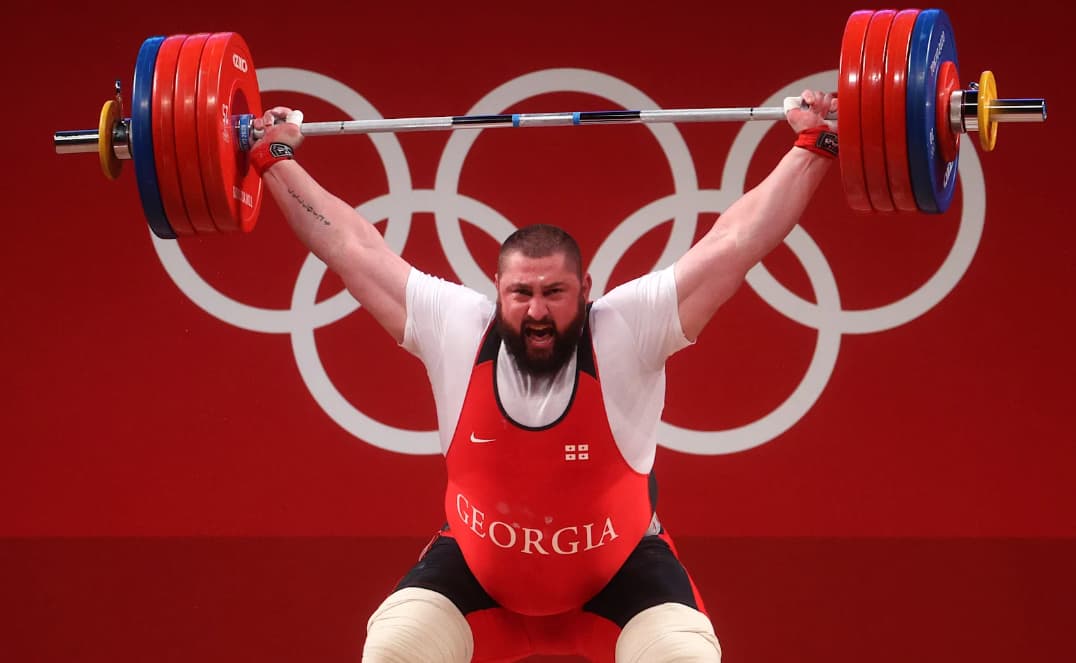27-year-old Lasha Talakhadze of Georgia is considered by many to be the greatest super heavyweight weightlifter of all time.
Standing at a towering 6’6” and weighing in at a massive 168kg (370 pounds), Talakhadze currently holds the world record in the men’s +109kg category with a lift of 484kg (1066 pounds) achieved at the 2017 World Weightlifting Championships.
Lasha Talakhadze Diet and Training Regimen for Olympic

With his giant yet muscular physique and almost supernatural strength, many casual observers may think that Talakhadze simply won the genetic lottery.
However, his legendary status has been hard-earned through extreme discipline in both diet and training. Let’s take a closer look at some of the key factors behind his astounding success.
Lasha Talakhadze Diet Overview
As an elite weightlifter competing in the unlimited heavyweight class, Talakhadze requires a massive amount of calories to support his extreme muscle mass and intense training regimen. However, he has to carefully manage his intake to ensure he stays in peak condition.
Here are some key aspects of his nutrition plan:
- High protein intake – As much as 3-4g per kg of body weight per day from sources like poultry, fish, eggs, and supplements. Protein provides the amino acids to build and repair muscle tissue.
- Carb timing – Increased carbs before/after workouts to promote recovery and muscle growth.
- Healthy calorie surplus – He consumes enough calories for muscle growth without unnecessary fat gain. His maintenance intake likely exceeds 5000 calories per day.
- Occasional treats – While he eats clean most of the time, Talakhadze allows himself a treat meal on special occasions without guilt or overindulgence.
Let’s expand on some of the specifics around his high-performance diet.
The Vital Importance of Protein
Protein is essential for building strength and muscle mass, so it’s a primary focus in Talakhadze’s nutrition. A study found that weightlifters eating 3.4g of protein per kg of body weight gained significantly more muscle than those consuming 2.3g/kg despite identical training programs [1].
At 168kg, this equates to around 570g protein per day for Lasha. Some foods he regularly eats to hit these high protein numbers include:
- Eggs: A complete protein source full of leucine to stimulate muscle growth. He may eat up to 10 whole eggs daily.
- Poultry: Chicken and turkey breasts are lean protein staples in his diet.
- Red meat: Provides protein along with iron, zinc, and vitamin B12 for performance.
- Fish: Cold water fatty fish like salmon offer protein as well as anti-inflammatory omega-3s.
- Dairy: Drinks milk and eats Greek yogurt for its high protein content.
- Protein supplements: He Likely uses whey and casein protein powders to supplement his diet.
Consuming adequate protein around workouts and before bed are two particularly important timing strategies for muscle gain that Talakhadze undoubtedly employs [2].
Carb Manipulation to Maximize Energy and Recovery
While protein takes center stage in Lasha’s diet, carbs also play a strategic role in fueling intense training while promoting optimal recovery.
His carb intake and timing revolve around his workout schedule:
- High-carb pre-workout meals: He consumes starchy carbs about 1-2 hours before lifting for energy. Sweet potatoes, oatmeal, and rice work well.
- Carbs during longer sessions: For workouts over 1 hour he takes in quick carbs like sports drinks or bananas to maintain blood sugar levels.
- High-carb post-workout meals: After training he prioritizes carbs along with protein to replenish glycogen stores. White rice or potatoes work great for maximizing the insulin response.
- Lower carb on rest days: Carbs are reduced when not training to prevent unnecessary fat gain.
This nutrient timing allows Lasha to put carbs to optimal use – avoiding both crashes during exercise and unwanted fat gains during inactivity.
Achieving an Astounding Calorie Surplus Without Fat Gain
To sustain his massive 370-pound physique and brutal training routine, Lasha’s caloric intake is truly epic. Various sports science models estimate his maintenance calories to be at least 5000 per day accounting for his extreme body mass and volume of intense exercise [3].
On top of this, he likely consumes an additional 500-1000+ calorie per day surplus during growth phases to pack on slabs of muscle without unwanted fat. This means he may be eating the equivalent of 10+ Big Macs daily!
However, his calories are coming from clean, high-protein foods rather than junk. This allows him to drive lean mass gains by:
- Consuming adequate protein to maximize muscle repair and growth.
- Strategically timing carbs to fuel activity and recovery.
- Focusing on calorically dense yet nutritious whole foods to hit high numbers without overspilling into fat storage.
- Keeping intense weightlifting as his primary training stimulus for gains.
By following these fundamental principles of muscular hypertrophy, Lasha builds unprecedented amounts of strength without sacrificing his athleticism – a challenge that would defeat most other strongmen who bulk well beyond their optimal functionality.
An Olympian’s Mindset – Moderate Treats Without Overindulgence
While discipline and determination are etched into Talakhadze’s granite persona, this doesn’t mean he denies himself from ever indulging.
Interestingly, studies show that scheduled treat meals may assist muscle growth when dieting is otherwise tight [4]. From a psychological perspective, scheduled rewards also boost motivation and discipline.
So while Lasha generally avoids sugar, excessive fat, and alcohol, he likely factors in occasional treats foods like pizza or sweets during purposeful refeed periods without guilt or overcompensation afterwards.
This moderate approach of focusing on high-quality nutrition 90% of the time while allowing some flexibility aligns with habits seen in many elite strength and physique athletes. It contributes to a positive and sustainable relationship with food.
After dominating on the platform, even an Olympic weightlifting legend needs to kick back and have some fun too!
Lasha Talakhadze Vital Stats
- Height: 6’6″ (198 cm)
- Weight: 168kg (370 pounds)
- Competition Weight Class: +109kg (Super heavyweight)
- Personal Records:
- Snatch – 220kg (2022 World Championships)
- Clean and jerk – 264kg (2017 World Championships)
- Total – 484kg (2017 World Championships, current world record)
Lasha Talakhadze Training Program Overview
Fueling a 370-pound body like Lasha’s requires extraordinary effort. But without intense training tailored to the sport of Olympic weightlifting, hitting record numbers would remain out of reach no matter how much he ate.
Here is a general overview of his training philosophy and techniques:
- High volume: He trains up to 6 hours a day, 6 days a week with very high total numbers of heavy lifts.
- His sessions attack different aspects of technique, mobility, strength, and power development.
- Mastery of the classic lifts: Talakhadze has perfected not just brute strength, but also lightning-quick technique required in the snatch and clean & jerk.
- Core focus: Building incredible stability and strength through the midsection allows him to harness power from the ground up.
- Recovery prioritized: With extremely taxing sessions, everything outside the gym revolves around optimizing rest and refueling.
Now let’s analyze some components of his training program design to better appreciate why he is capable of such magnificent feats of power and speed.
Developing Stabilizing Strength Through the Core and Back
Generating over 25,000 pounds of ground force to lift 500kg requires a body of tremendous internal pressure. The heavier Talakhadze has gotten, the more his static strength base resembles that of an oak tree to support outrageous loads.
To ensure his spine doesn’t buckle under 1066 pounds, some of his key training goals include:
- Thickening the torso with heavy compound exercises like squats, deadlifts, overhead presses, rows, and pulldowns. This develops the intercostals, obliques, erectors, rhomboids, and lats to stabilize and protect the core.
- Direct ab training through movements like hanging leg raises, cable crunches, ab wheel rollouts, and suitcase carry among many others. Building dynamic strength straight through the abdominal muscles translates into more force transfer on the platform.
- Perfecting breathing and bracing techniques so he can properly brace his core by creating significant intra-abdominal pressure during each rep.
- Improving hip and ankle mobility to maintain an upright torso position which keeps the bar path tight and leverages efficiency.
His rigorous attention to these areas gives Talakhadze the postural integrity and stability to catch monumental weights without failing structurally.
Practicing the Competition Lifts – Snatch and Clean & Jerk
To excel as a weightlifter, you need to become proficient in the snatch and the clean & jerk – the two competition lifts. Success in Olympic lifting requires not just brute force but also tremendous speed, agility, timing, finesse, and flawless technique.
Although gifted with unprecedented power, Talakhadze trains these complex movements daily with precision and intensity – not just going through the motions but continually striving to improve:
- Training sessions typically begin by thoroughly warming up and practicing components of each lift with PVC pipes and light weights. This grooves proper motor patterns.
- He then methodically progresses to technique work with weights between 30-70% of 1RM, focusing intensely on dialing in positions and timing before increasing load.
- Heavy singles, doubles or triples above 90% 1RM are then performed to build strength and skill while managing fatigue.
- Accessory exercises, specialized machines, and cross-training are strategically incorporated to target individual weaknesses.
This well-structured process allows strength and muscle memory to accumulate so he can nail competition attempts when the pressure and fatigue are turned up to the max.
Recovery and Restoration Between Brutal Training Sessions
When your 200kg squat workout is just an average day in the gym, accumulating sufficient rest becomes perhaps the greatest challenge. With training demands bordering on the extreme, Lasha prioritizes recovery through:
- Getting at least 8-9 hours of sleep nightly.
- Taking scheduled rest days and avoiding overtraining.
- Eating enough protein and calories to fully repair damaged muscle tissue.
- Utilizing sports massages, cold water immersion, compression wear, and other techniques to help his body rebound.
- Avoid unnecessary risks, altered rest states, or anything else that could lead to injury and derail progress.
Because he trains with such remarkable intensity, what Talakhadze does outside the gym to refuel and recharge likely makes an even greater contribution to his sustained dominance than the actual work sets themselves.
His careful management of rest allows him to keep returning to bury PR after PR under ever-increasing loads.
Frequently Asked Questions
- Q: What is Lasha Talakhadze’s competition bodyweight?
A: Talakhadze competes in the heaviest men’s super heavyweight category, which is +109kg. His body weight is typically between 160-175kg or 350-385 lbs.
- Q: How many calories does Lasha Talakhadze eat per day?
A: Estimates put his maintenance calories around 5000 per day minimum. During growth phases, he may consume 5500-6000 calories or more to drive muscle hypertrophy.
- Q: What is the staple food in Lasha Talakhadze’s diet?
A: As a dedicated athlete who trains for hours each day, Lasha’s staple foods provide quality protein and complex carbs. This includes eggs, poultry, fish, red meat, potatoes, rice, vegetables, and fruits.
- Q: How much can Lasha Talakhadze deadlift?
A: While Olympic weightlifting does not involve the deadlift, as an elite strongman Talakhadze likely possesses brute strength allowing him to deadlift over 900 lbs / 400 kg.
- Q: What muscles or body parts does Lasha Talakhadze train most often?
A: To generate extraordinary force against the ground while maintaining sound structure, Lasha dedicates considerable effort to strengthening his core, torso, back, hips, and legs.
More Related Guides:
Conclusion
Lasha Talakhadze has demonstrated what rigorous adherence to world-class physical preparation and lifestyle habits can achieve.
From his precision nutrition emphasizing quality calories and protein to relentless, technically proficient training, every component of his regimen is meticulously dialed toward performance.
While genetics may separate the elite from the average, without this level of diligence Talakhadze could never have attained such astounding results.
His example reminds us that virtually all people possess far more strength – both inner and outer – than we may recognize if we commit ourselves fully to the task.
Though his unprecedented numbers may be out of reach for casual athletes, the principles and mindset that guide his success can most certainly inspire our journeys toward greatness.
If this analysis of his journey helps provide ideas, structure, or motivation for you to take your training, fitness, or health to the next level, I’ll consider these words well-written.



